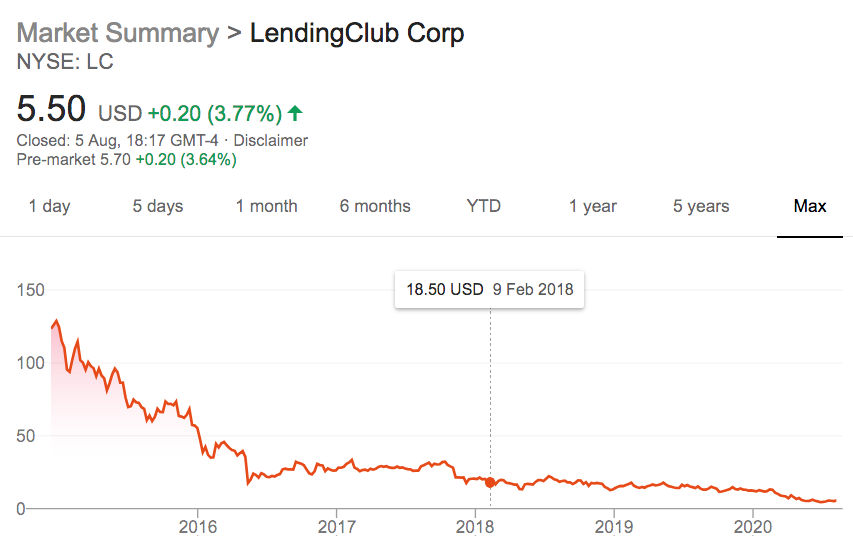Where Are We Now? Direct Lending Benchmarks Revisited
 There’s more news from the troubled Lending Club – the direct lender (or marketplace or peer-to-peer [P2P} lender) that has long been seen as a leader in the market in the United States. We take an interest in Lending Club for a number of reasons, not least because its success or otherwise has a direct bearing on the way the fast-evolving direct-lending market in the UK is perceived.
There’s more news from the troubled Lending Club – the direct lender (or marketplace or peer-to-peer [P2P} lender) that has long been seen as a leader in the market in the United States. We take an interest in Lending Club for a number of reasons, not least because its success or otherwise has a direct bearing on the way the fast-evolving direct-lending market in the UK is perceived.
Lending Club’s loan originations of $325.8 million in the second quarter of 2020, down 90 per cent year over-year. AltFi reports:

The marketplace lending giant, like many other lenders around the world has been deeply affected by the spread of the coronavirus and the subsequent lockdowns and uncertain economic environment.
It says that in the period it took “decisive actions” to reduce cash expenses and preserve liquidity but that ultimately lending fell substantially, hitting revenues.
Lending Club made a net loss for the quarter of $78.5m owing to the fall in originations but emphasised this was in line with our expectations. Net Revenue was $43.9m, down 77 per cent year-on-year.

- Below we quote an extract from a December 2104 blog from our communications director, writing at the time of Lending Club’s IPO. Was he right? Read below, check out the graphic with this article, and draw your own conclusions. For clarity, just after the IPO, the stock price peaked at over $128 – it is currently trading around $5.
[The] aggressive pricing of Lending Club is just that – aggressive. The bankers behind Lending Club’s IPO have played the media like a knackered trout. They were going to price this asset at nearer $4 billion than $5 billion – still a huge price. But now the financial rabbit has been pulled out of the hat, and here’s Lending Club – fluffy, cute, and possibly just a bit too expensive for its own good.
Perfect market theorists argue that the market will be the ultimate arbiter. What’s something worth? What the market will pay for it. After all the rationally relevant information has been priced in, the market will determine fair value.
It would be difficult to argue with that. The horrendous bubble in technology stocks – created by the greed of investment bankers and investors alike – finally burst in March 2000 (not long after the IPO of lastminute.com). The market had its say.
It will have its say with Lending Club – and then, pretty soon I’m guessing, with Funding Circle, and maybe a few other UK-based P2P lenders. If Lending Club proves to be overpriced, it will damage confidence in the price of the stocks, and – unfairly – in the P2P lending sector itself.
It is to be hoped that the market finds Lending Club’s valuation fair from the get-go. But hope rarely triumphs over expectation.

Historical Performance And IFISA Process Guide
- Money&Co. lenders have achieved an average return of more than 8 per cent gross (before we deduct our one per cent fee).
That figure is the result of over £21 million of loans facilitated on the site, as we bring individuals looking for a good return on capital together with carefully vetted small companies seeking funds for growth. Bear in mind that lenders’ capital is at risk. Read warnings on site before committing capital.
- Money&Co. has been lending for over 5 years and has only had two bad debts so far, representing a bad debt rate of 0.03 per cent per annum.
All loans on site are eligible to be held in a Money&Co. Innovative Finance Individual Savings Account (IFISA), up to the annual ISA limit of £20,000. Such loans offer lenders tax-free income. Our offering is an Innovative Finance ISA (IFISA) that can hold the peer-to-peer (P2P) business loans that Money&Co. facilitates. For the purposes of this article, the terms ISA and IFISA are interchangeable.
So here’s our guide to the process:
- Step 1: Register as a lender. Go to the login page, and go through the process that the law requires us to effect. This means we have to do basic checks on you to comply with money-laundering and other security requirements.
- Step 2: Put money into your account. This is best done by electronic transfer. We can also process paper cheques drawn in favour of Denmark Square Limited, the parent company of Money&Co.
- Step 3: Buy loans in the loan market. Once you’ve put cash in your account it will sit there – and it won’t earn interest until you’ve bought a piece of a loan. It’s this final step that requires lenders and IFISA investors to be pro-active. Just choose some loans – all loans on the Money&Co. site can be held in an IFISA – and your money will start earning tax-free interest.
The ISA allowance for 2019/20 is unchanged from last tax year at £20,000, allowing a married couple to put £40,000 into a tax-free environment. Over three years, an investment of this scale in two Money&Co. Innovative Finance ISAs would generate £8,400 of income completely free of tax. We’re assuming a 7 per cent return, net of charges and free of tax here.
Once you have made your initial commitment, you might then consider diversifying – buying a spread of loans. To do this, you can go into the “loans for sale” market. All loans bought in this market also qualify for IFISA tax benefits.

Risk: Security, Access, Yield
Do consider not just the return, but the security and the ease of access to your investment. We write regularly about these three key factors. Here’s one of several earlier articles on security, access and yield.
